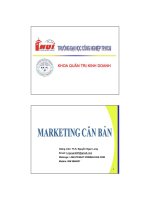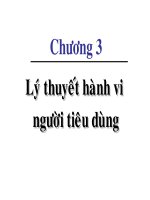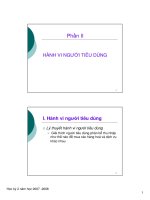Slide hành vi người tiêu dùng chương 8 buying and disposing
Bạn đang xem bản rút gọn của tài liệu. Xem và tải ngay bản đầy đủ của tài liệu tại đây (1.46 MB, 35 trang )
.c
om
Chapter 8
ng
th
an
co
ng
Buying and Disposing
cu
u
du
o
CONSUMER
BEHAVIOR, 8e
Michael Solomon
CuuDuongThanCong.com
/>
Chapter Objectives
.c
om
When you finish this chapter you should understand why:
• Many factors over and above the qualities of the product or
co
ng
service influence the outcome of a transaction. Factors at the
time of purchase dramatically influence the consumer decisionmaking process.
th
an
• In addition to what a shopper already knows or believes about
ng
a product, information, a store, or Web site provides can
strongly influence a purchase decision.
du
o
• A salesperson can be the crucial link between interest in a
cu
u
product and its actual purchase.
Hoang Duc Binh, 2008
CuuDuongThanCong.com
/>
Chapter Objectives (cont.)
.c
om
• Marketers need to be concerned about a consumer’s
ng
evaluations of a product after he buys it as well as
before.
co
• Getting rid of products when consumers no longer
cu
u
du
o
ng
th
an
need or want them is a major concern both to
marketers and to public policy makers.
Hoang Duc Binh, 2008
CuuDuongThanCong.com
/>
Issues Related to Purchase and
Postpurchase Activities
.c
om
• A consumer’s choices are affected by many
cu
u
du
o
ng
th
an
co
ng
personal factors…and the sale doesn’t end at the
time of purchase
Hoang Duc Binh, 2008
Figure 10.1
CuuDuongThanCong.com
/>
.c
om
Situational Effects on Consumer
Behavior (cont.)
behavioral or perceptual
th
specific occasions
an
• We tailor purchases to
co
• Situational effects can be
ng
Consumption situation
ng
• The way we feel at a
u
du
o
particular time affects what
we buy or do
cu
• Day Reconstruction Method
• Situational self-image (“Who
am I right now?”)
Hoang Duc Binh, 2008
CuuDuongThanCong.com
/>
Social and Physical Surroundings
.c
om
Affect a consumer’s motives for product usage and
product evaluation
ng
th
an
co
ng
• Décor, odors, temperature
• Co-consumers as product attribute
• Large numbers of people = arousal
• Interpretation of arousal: density versus
du
o
u
cu
•
crowding
Type of consumer patrons
Hoang Duc Binh, 2008
CuuDuongThanCong.com
/>
Temporal Factors
.c
om
Economic time
• Time style: consumers try to
co
ng
maximize satisfaction by
dividing time among tasks
cu
u
du
o
ng
th
an
• Time poverty
• One-third of Americans
feel rushed
• Marketing innovations
allow us to save time
• Polychronic
activity/multitasking
Hoang Duc Binh, 2008
CuuDuongThanCong.com
/>
Temporal Factors (cont.)
.c
om
Psychological time: consumers’ perception of time
co
ng
• Fluidity of time (subjective experience)
• Time categories relevant to marketers
th
an
• Good times for ads: occasion/leisure times and time to kill
• Bad times for ads: flow and deadline times
u
du
o
Time is a pressure cooker
Time is a map
Time is a mirror
Time is a river
Time is a feast
cu
•
•
•
•
•
ng
• Time perspective metaphors
Hoang Duc Binh, 2008
CuuDuongThanCong.com
/>
Temporal Factors (cont.)
th
an
co
ng
.c
om
• Experience of time results from culture
• Linear separable time
• Procedural time
• Circular/cyclic time
• Queuing theory: mathematical study of waiting
cu
u
du
o
ng
lines
• Waiting for product = good quality
• Too much waiting = negative feelings
• Marketers use “tricks” to minimize psychological
waiting time
Hoang Duc Binh, 2008
CuuDuongThanCong.com
/>
cu
u
du
o
ng
th
an
co
ng
.c
om
Drawings of Time
Hoang Duc Binh, 2008
Figure 10.2
CuuDuongThanCong.com
/>
The Shopping Environment
ng
Pleasure and arousal
co
Mood = combination of pleasure and arousal
• Happiness = high in pleasantness and moderate in arousal
• Mood biases judgments of products/services
• Moods are affected by store design, music, TV programs
u
•
Hedonic reasons include:
• Social experiences
cu
•
du
o
Reasons for shopping:
ng
th
an
•
•
.c
om
Antecedent states: mood/physiological condition influences what
we buy and how we evaluate product
Vary by product category, store type, and culture
• Sharing of common interests
• Interpersonal attraction
• Instant status
Hoang Duc Binh, 2008
• The thrill of the hunt
CuuDuongThanCong.com
/>
cu
u
du
o
ng
th
an
co
ng
.c
om
Dimensions of Emotional States
Hoang Duc Binh, 2008
Figure 10.3
CuuDuongThanCong.com
/>
.c
om
Reasons for Shopping
Reasons for shopping:
ng
• Vary by product category,
co
store type, and culture
ng
th
an
• Hedonic reasons include:
• Social experiences
• Sharing of common
du
o
u
cu
•
•
•
interests
Interpersonal attraction
Instant status
The thrill of the hunt
Hoang Duc Binh, 2008
CuuDuongThanCong.com
/>
E-Commerce: Clicks versus Bricks
.c
om
• E-commerce reaches
co
ng
customers around the world,
but competition increases
exponentially
th
an
• Benefits: good customer
ng
service, technology value
cu
u
Click photo for
Bluefly.com
du
o
• Limitations: security/identity
theft, actual shopping
experience, large
delivery/return shipping
charges
Hoang Duc Binh, 2008
CuuDuongThanCong.com
/>
Discussion
.c
om
• Will e-commerce eventually replace traditional brickand-mortar retailing? Why or why not?
co
ng
• What are the benefits that traditional retail stores
cu
u
du
o
ng
th
an
provide that e-commerce cannot provide?
Hoang Duc Binh, 2008
CuuDuongThanCong.com
/>
Retailing as Theater
nonstore alternatives multiply
.c
om
• Competition for customers is becoming intense as
cu
u
du
o
ng
th
an
co
ng
• Malls gain loyalty by appealing to social motives
• Retail techniques:
• Landscape themes
• Marketscape themes
• Cyberspace themes
• Mindscape themes
Hoang Duc Binh, 2008
CuuDuongThanCong.com
/>
.c
om
Store Image
Store image: personality of the store
ng
• Location + merchandise suitability +
co
knowledge/congeniality of sales staff
cu
u
du
o
ng
th
an
• Some factors in overall evaluation of a store:
• Interior design
• Types of patrons
• Return policies
• Credit availability
Hoang Duc Binh, 2008
CuuDuongThanCong.com
/>
.c
om
FedEx Makeover
AFTER
cu
u
du
o
ng
th
an
co
ng
BEFORE
Hoang Duc Binh, 2008
CuuDuongThanCong.com
/>
Discussion
.c
om
• The mall of the future will most likely be less about
ng
purchasing products than exploring them in a
physical setting.
co
• This means that retail environments will have to
ng
th
an
become places to build brand images, rather than
just places to sell products.
du
o
• What are some strategies stores can use to enhance
cu
u
the emotional/sensory experiences their customers
receive?
Hoang Duc Binh, 2008
CuuDuongThanCong.com
/>
cu
u
du
o
ng
th
an
co
ng
.c
om
FedEx Brand Image: Brand Position
Hoang Duc Binh, 2008
CuuDuongThanCong.com
/>
Atmospherics
co
• Colors/lighting, scents, and
ng
.c
om
Atmospherics: conscious designing
of space and dimensions to evoke
certain effects
th
an
sounds/music affect time spent in
store and spending
Click for
Buildabear.com
cu
u
du
o
ng
• Activity stores
• Build-A-Bear Workshop
• Club Libby Lu
• Viking Home Chef and Viking
Culinary Academy
Hoang Duc Binh, 2008
CuuDuongThanCong.com
/>
In-Store Decision Making
an
co
ng
.c
om
• Spontaneous shopping consists of:
• Unplanned buying: reminded to buy something
• Impulse buying: sudden, irresistible urge to buy
• Point-of-purchase (POP) stimuli: product display or
du
o
ng
th
demonstration that draws attention
• Music store CD sampler, Elizabeth Arden
computer and video makeover system
cu
u
• Salesperson create exchange process
• Commercial friendships
Hoang Duc Binh, 2008
CuuDuongThanCong.com
/>
cu
u
du
o
ng
th
an
co
ng
.c
om
Image of an Impulse Buyer
Hoang Duc Binh, 2008
Figure 10.4
CuuDuongThanCong.com
/>
Discussion
.c
om
• What qualities seem to differentiate good and bad
salespeople?
co
ng
• In what retail outlets do you tend to find “good”
cu
u
du
o
ng
th
an
salespeople? Why?
Hoang Duc Binh, 2008
CuuDuongThanCong.com
/>
Postpurchase Satisfaction
.c
om
• Postpurchase satisfaction or dissatisfaction is
ng
determined by attitude about a product after
purchase
co
• Marketers constantly on lookout for sources of
cu
u
du
o
ng
th
an
consumer dissatisfaction
• United Airlines’ “United Rising” campaign
Hoang Duc Binh, 2008
CuuDuongThanCong.com
/>









